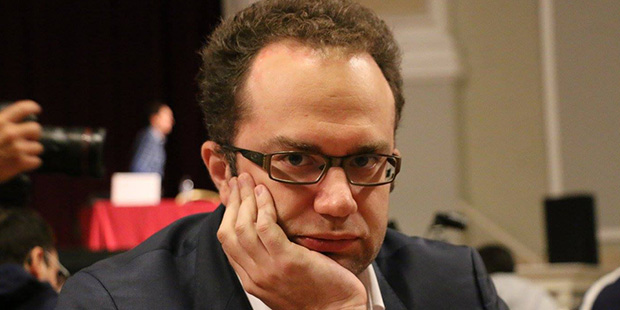
The Isle of Man is a small island in the UK. It is actually located in the Irish Sea, between Great Britain and Ireland. Largely unpopulated, the Isle of Man boasts amazing landscapes and is home to 17 national glens branching from the sea, as well as numerous gardens, parks and other attractions.
From October 1st to 9th the island played host to an international chess tournament. The event, a nine-round swiss, was organised by the Isle of Man International Chess Committee and chess.com who sponsored the event. Held at the Villa Marina & Gaiety Theatre, in Douglas, three sections would be contested, Minor, Major and Masters. The £12,000 ($14,866, €13,317) purse for the Masters section, attracted top GM’s from all over. Top seed was Fabiano Caruana of the United States of America, with his rating of 2808, narrowly over fellow countrymen Hikaru Nakamura (2789) and Wesley So (2782). Other players included Pavel Eljanov, Michael Adams, David Howell, Peter Leko, Hou Yifan, Arkadij Naiditsch, Anna Ushenina, Gabriel Sargissian and Alexei Shirov.
The event was won by Ukranian Grandmaster, Pavel Eljanov on tie-breaks. Eljanov had scored 7½/9 along with Fabiano Caruana, but took first prize on progressive score in order to take first place. Alexei Shirov had been an early leader, but Eljanov’s defeat of Shirov in round six (game, below) bumped the Latvian down out of the top ten. This proved very costly to Shirov’s chances of victory in the tournament.
From here, Eljanov made the top slot his own and it was only in the final round that he was caught by Caruana, who had defeated British GM Michael Adams — Eljanov shared the spoils of his final game with Wesley So. Just behind Eljanov and Caruana, was Arkadij Naiditsch on 7/9. Naiditsch had also been victim to Eljanov during the tournament, ultimately spoiling his chances of first place.
Final Standings:
- Eljanov, Caruana — 7½
- Naiditsch — 7
- So, Shirov, Salem, Howell — 6½
- Nakamura, Adams, Rodshtein, Vidit, Fressinet, Sargissian, Granda Zuniga, Grandelius, L’ami, Lenderman, Brunello, Aravindh — 6
[Site “Villa Marina”]
[Date “2016.10.06”]
[Round “6.1”]
[White “Eljanov, Pavel”]
[Black “Shirov, Alexei”]
[Result “1-0”]
[BlackClock “0:02:56”]
[BlackElo “2679”]
[ECO “A07”]
[EventDate “2016.??.??”]
[WhiteClock “0:10:09”]
[WhiteElo “2741”]
{ Annotations by John Lee Shaw for www.hotoffthechess.com. } 1.Nf3 d5 2.g3 Bg4 3.Bg2 Nd7 4.O-O Ngf6 5.h3 Bxf3 6.Bxf3 e6 7.d3 Bd6 8.Bg2 O-O 9.Nd2 c6 10.e4 e5 11.a4 { Taking a different route than the usual 11…exd5. } 11…a5 12.exd5 cxd5 { Slightly preferable to …Nd5, but it was a playable alternative } ( 12…Nxd5 13.Nc4 Bc5 14.Bd2 Qc7 { and Black is equal at worst here. } ) 13.Nb1 Bb4 14.c3 Bd6 15.Na3 Bxa3 { This wasn’t a mandatory capture, Black could have continued to develop with …Rc8, for example. Perhaps Shirov was a little worried about Nb5, but this is answered fine by …Bb8. } 16.Rxa3 Rc8 17.Rb3 b6 18.Rb5 Nc5 { The more confrontational …Rc5 would have been better, demanding that White make a decision. This move is not really adequate due to White’s next. } ( 18…Rc5 19.Rxc5 Nxc5 20.d4 exd4 { and Black should be ok after the likely Qxd4. } ) 19.d4 exd4 20.Qxd4 { To have gone for cxd4 would have been misguided. It is true that there is a tempo on the knight, but after …Ne6, the that is turned on its head and White has the d-pawn to look after. } 20…Nfe4 21.Bf4 { White’s bishop pair looks extremely sweet, firing across the board right towards the theatre of campaign. Compared to Black’s knights, they are in a class of their own. } 21…Nd6 { One has to wonder about this move. Unmasking the g2-bishop’s firing line along the diagonal, it just seems to surrender a pawn. } 22.Bxd6 Qxd6 23.Bxd5 Rfd8 24.Rd1 { Clearly with a substantial advantage, here. } 24…Qg6 { Not only is Black a pawn down, but he also does not have a very active stance. It is not a disaster to be worse in chess, as long as there is some activity and ability to fight and cause complications for the opponent. Black does not have any of this, his rooks are largely impotent on their files and his knight is at the moment a bystander. } 25.Qg4 { This makes perfect sense, with an extra pawn one should often seek the endgame as soon as possible. But also, the Black Queen is Shirov’s most active piece at this time, so getting it off the board is a big plus for White. } 25…Qxg4 { For reasons already given, it will not have pleased Shirov to exchange Queens here. There was no good way of avoiding it, however, so it is very much a case of the lesser of evils. } 26.hxg4 Nxa4 ( 26…Rb8 27.Rd4 Kf8 28.f4 { sees White with a strong initiative. } ) 27.Rd4 Nc5 { Black has his pawn back, but this has cost time and has done nothing for his activity. Plus, it is only a temporary situation. } 28.Rxb6 Kf8 29.g5 { This, in essence, is a nice constructive waiting move. Not only covering f6 and h6, but also saying to Black “ok, sort things out.” } 29…Rb8 { I am not sure this is the way to go about defending, it seems more of an admission of big problems. Being a pawn down, each exchange by Black is a concession for defending against a superior force later on. } 30.Rxb8 Rxb8 31.Rf4 Ke7 { Reaping the rewards of his early g4-g5. White has sown the seeds and watches his opponent’s position steadily deteriorate. } 32.Rxf7+ Kd6 33.c4 g6 34.Rxh7 Rxb2 35.Rg7 a4 36.Rxg6+ Ke5 37.Rg7 a3 { This pawn is a mere pretender. Eljanov has everything under control, here and converts nicely. } 38.Ra7 a2 39.g6 { And Shirov resigned, White has an overwhelming position and is in full control. } 1-0
[/pgn]

